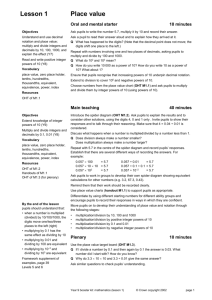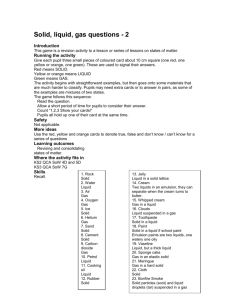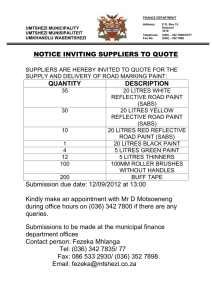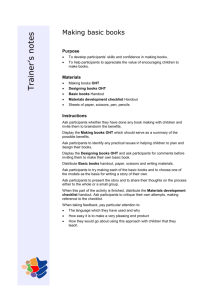Key Stage 3 Pilot
advertisement
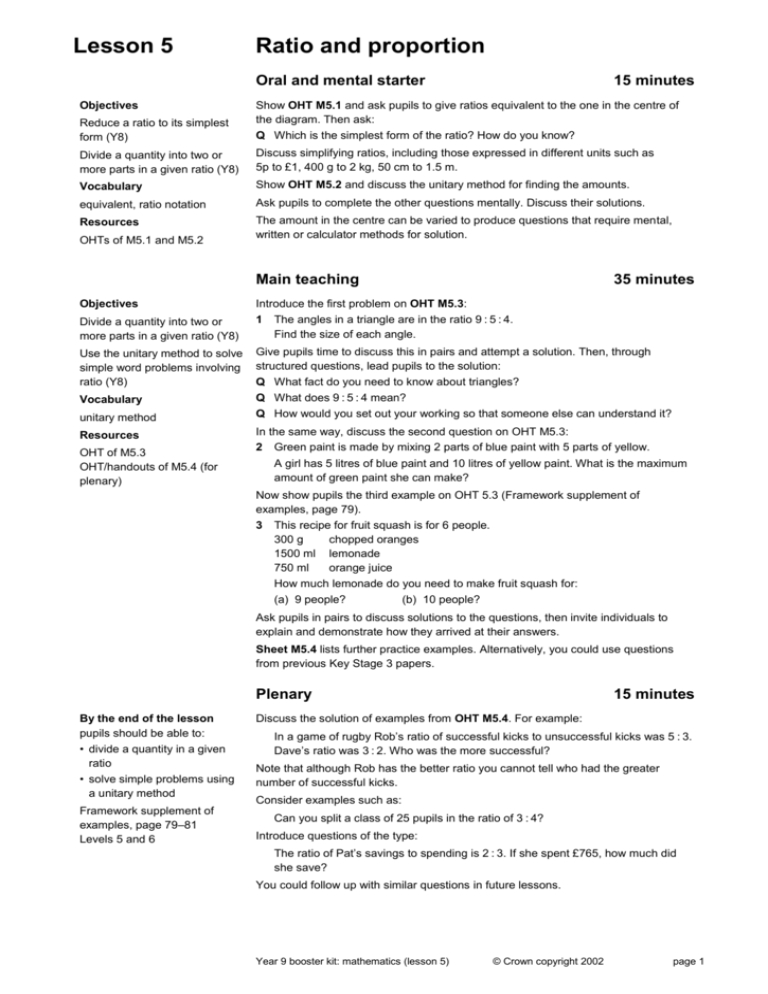
Lesson 5 Ratio and proportion Oral and mental starter Objectives 15 minutes Reduce a ratio to its simplest form (Y8) Show OHT M5.1 and ask pupils to give ratios equivalent to the one in the centre of the diagram. Then ask: Q Which is the simplest form of the ratio? How do you know? Divide a quantity into two or more parts in a given ratio (Y8) Discuss simplifying ratios, including those expressed in different units such as 5p to £1, 400 g to 2 kg, 50 cm to 1.5 m. Vocabulary Show OHT M5.2 and discuss the unitary method for finding the amounts. equivalent, ratio notation Ask pupils to complete the other questions mentally. Discuss their solutions. Resources The amount in the centre can be varied to produce questions that require mental, written or calculator methods for solution. OHTs of M5.1 and M5.2 Main teaching 35 minutes Objectives Introduce the first problem on OHT M5.3: Divide a quantity into two or more parts in a given ratio (Y8) 1 Use the unitary method to solve simple word problems involving ratio (Y8) Vocabulary Give pupils time to discuss this in pairs and attempt a solution. Then, through structured questions, lead pupils to the solution: Q What fact do you need to know about triangles? Q What does 9 : 5 : 4 mean? unitary method Q How would you set out your working so that someone else can understand it? Resources In the same way, discuss the second question on OHT M5.3: 2 Green paint is made by mixing 2 parts of blue paint with 5 parts of yellow. OHT of M5.3 OHT/handouts of M5.4 (for plenary) The angles in a triangle are in the ratio 9 : 5 : 4. Find the size of each angle. A girl has 5 litres of blue paint and 10 litres of yellow paint. What is the maximum amount of green paint she can make? Now show pupils the third example on OHT 5.3 (Framework supplement of examples, page 79). 3 This recipe for fruit squash is for 6 people. 300 g chopped oranges 1500 ml lemonade 750 ml orange juice How much lemonade do you need to make fruit squash for: (a) 9 people? (b) 10 people? Ask pupils in pairs to discuss solutions to the questions, then invite individuals to explain and demonstrate how they arrived at their answers. Sheet M5.4 lists further practice examples. Alternatively, you could use questions from previous Key Stage 3 papers. Plenary By the end of the lesson pupils should be able to: • divide a quantity in a given ratio • solve simple problems using a unitary method Framework supplement of examples, page 79–81 Levels 5 and 6 15 minutes Discuss the solution of examples from OHT M5.4. For example: In a game of rugby Rob’s ratio of successful kicks to unsuccessful kicks was 5 : 3. Dave’s ratio was 3 : 2. Who was the more successful? Note that although Rob has the better ratio you cannot tell who had the greater number of successful kicks. Consider examples such as: Can you split a class of 25 pupils in the ratio of 3 : 4? Introduce questions of the type: The ratio of Pat’s savings to spending is 2 : 3. If she spent £765, how much did she save? You could follow up with similar questions in future lessons. Year 9 booster kit: mathematics (lesson 5) © Crown copyright 2002 page 1 Ratio spider diagram 1 Year 9 booster kit: mathematics (lesson 5) © Crown copyright 2002 M5.1 page 2 Ratio spider diagram 2 Year 9 booster kit: mathematics (lesson 5) © Crown copyright 2002 M5.2 page 3 Ratio problems 1 M5.3 1 The angles in a triangle are in the ratio 9 : 5 : 4. Find the size of each angle. 2 Green paint is made by mixing 2 parts of blue paint with 5 parts of yellow. A girl has 5 litres of blue paint and 10 litres of yellow paint. What is the maximum amount of green paint she can make? 3 This recipe for fruit squash is for 6 people. 300 g chopped oranges 1500 ml lemonade 750 ml orange juice How much lemonade do you need to make fruit squash for: (a) 9 people? (b) 10 people? Year 9 booster kit: mathematics (lesson 5) © Crown copyright 2002 page 4 Ratio problems 2 M5.4 1 In a game of rugby Rob’s ratio of successful to unsuccessful kicks was 5 : 3. Dave’s ratio was 3 : 2. Who was the more successful? 2 The gears of a bicycle travelling along a flat road are such that for every 2 turns of the pedals the rear wheel makes 5 turns. If the pedals make 150 turns, how many turns will the rear wheel make? When travelling up a steep hill in a different gear, would you expect the rear wheel to make more or less than 5 turns for each 2 turns of the pedals? Explain your answer. 3 The answers to a survey are shown in a pie chart. The angle representing ‘Yes’ is 120°, the angle for ‘No’ is 150°, and the angle for ‘Don’t know’ is 90°. If 300 people took part in the survey, how many replied ‘No’? Year 9 booster kit: mathematics (lesson 5) © Crown copyright 2002 page 5
![[Agency] recognizes the hazards of lead](http://s3.studylib.net/store/data/007301017_1-adfa0391c2b089b3fd379ee34c4ce940-300x300.png)
